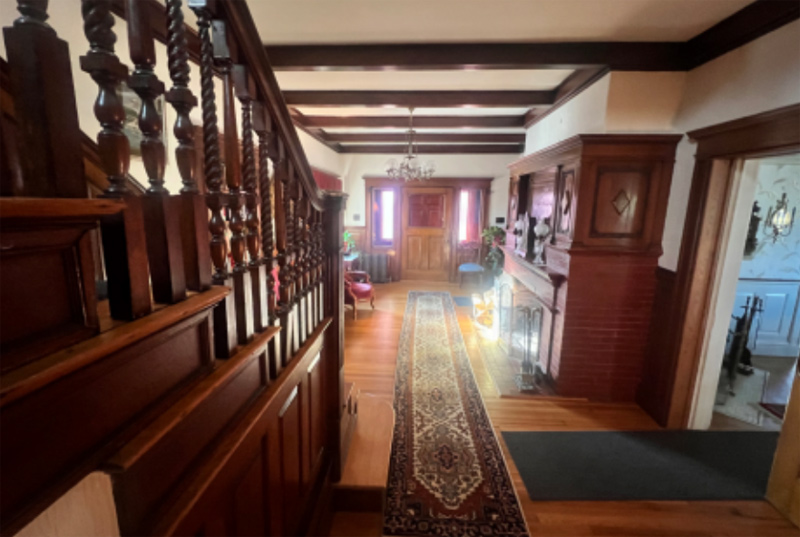
The staff at the Boston Landmarks Commission this week recommended that the Fox House on Metropolitan Avenue at Maynard Street in Roslindale be designated an official city landmark for both its architectural history and qualities and the lives of some of its early owners.
318 Metropolitan Avenue is a large, elegant house that combines the asymmetrical massing, wrap-around porch, and window detailing of the Queen Anne style with the Doric columns and triangular pedimented portico of the Colonial Revival style. The house, as it stands today, is half the original house, as it was cut in two in 1943 and the smaller half moved to 44 Maynard Street. The house is prominently sited on its extremely large corner lot on the eastern slope of the Clarendon Hills, with a view of the Great Blue Hill in Milton, and benefiting from the cooling breeze from the hills in the summer. In its original form it dominated the streetscape of somewhat smaller smaller scale houses around, and even today it remains a high point of the area, holding an imposing form as it is approached on Metropolitan Avenue from either above or below.
The construction of the original house, with its 24 rooms and portico-connected stable, took one year and 4 months, between 11th September 1899 and 25th January 1901, and was built as a single-family residence for the Fox family. The architect was James Murray, a well known local architect who lived on Poplar St, Roslindale.
Unlike the story that has long floated around the neighborhood, the house is not named for William Fox, who founded 20th Century Fox and who, the story goes, summered in Roslindale, but for Albert and Isabella Fox, who, along with their daughter, Blanche Hamilton Fox, were prominent in their own way:
Albert Fox was an important figure in newspaper advertising in the late nineteenth and early twentieth centuries, serving as the advertising manager of the Boston Post and the Boston Journal, and later working for newspapers in New York and Paris. Albert’s daughter Blanche Hamilton Fox was an international opera star whose European and American performances were reported on by papers across the United States.
Fox did such a good job selling ads for the Globe, he attracted the attention of a New York publisher, who convinced him to take a job there. Meanwhile, Blanche was getting into the papers for another reason - her voice:
In February 1906, under her Italian pseudonym "Bianca Volpini" (Little White Fox), she gave her premier professional performance at the Teatro Civico in the city of Vercelli, as Leonora in "La Favorita". It was a complete success, bringing accolades from US and European papers such as the Globe, the New York Times and even southern California papers (which noted she was well-known in that area through family travels to see Albert's brother). When she returned home in 1906, the headline in the Globe was "Roslindale Girl Made a Successful Debut in Grand Opera Abroad". Blanche had put Roslindale on the map. When she was not traveling for her opera performances, she continued to reside at 318 Metropolitan Avenue.
Eventually, though, the Foxes moved out of Roslindale - and sold the house to the Carrolls:
Francis Carroll, the patriarch of the family that bought the house from the Foxes, was a close ally of Mayor John F. Fitzgerald, serving in a number of appointed roles including as a Fire Safety Commissioner. He was also a prominent lawyer for the City of Boston.
The report notes that, in addition to the Victorian exterior, the house retains much of its original interior:
Despite being cut in two in 1943, the interior of 318 Metropolitan Avenue still remains surprisingly intact, especially the first floor.
The front door and front vestibule retain their original layout as described in the 1899 plans, and open into the entrance hall. This entrance hall contains the original oak panelling on the walls, and around the original fireplace, featuring the Scottish motto ‘East, West, Hame's Best’, (this motto, can also be found, for example, written on the Leith Tower of Castle Fyvie in Aberdeen, Scotland built by Lord Leith in 1900). This panelling hides original gas piping and electrical connection points for lights on either side of the fireplace which are no longer extant. The brick work inside the fireplace is original, although the exterior apron brick work has been replaced. The flooring, radiators and ceiling beams are original.

Because of that, the report urges the commission to give landmark status to not just the exterior, but the interior as well, which means any major alterations would need commission review first.
The house today is owned by Vissia Viglietta and Adam Shutes - the former owner of a cheese shop in Roslindale Square, who not only helped the commission with its research, but compiled his own history of the house and its surroundings.
The commission will consider the landmark recommendation at a meeting on March 11.
Complete commission report.
Provide feedback on the landmark recommendation.
Like the job UHub is doing? Consider a contribution. Thanks!
Ad:
Comments
They did great housing work
By Don't Panic
Fri, 02/21/2025 - 12:54am
They did great housing work back in the turn of the 20th century. I get that it was a mansion but I've seen attention to detail like this in much smaller houses that were built in that same time period.
I wonder if something like this could be built in our current century?
For $$$$$$, sure
By Oxenfree
Fri, 02/21/2025 - 11:41am
To get that level of care and quality, you'd probably have to hire people to make everything custom and/or hire people who specialize in historical architecture and building practices. No balloon framing here! It would certainly cost far, far more than even a "luxury" modern house.
Add comment